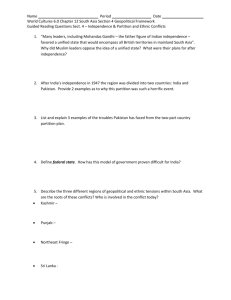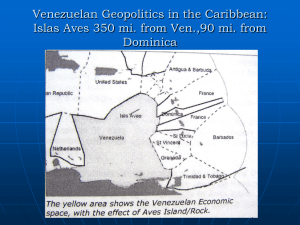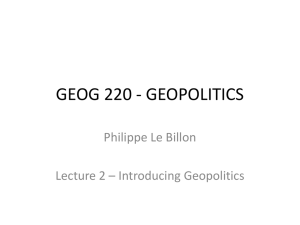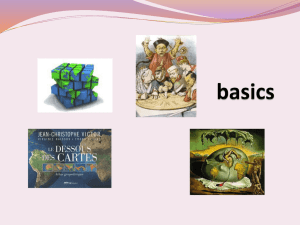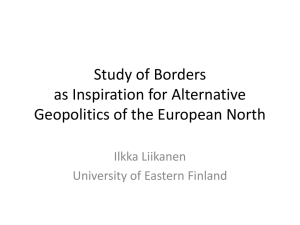please find course notes on geopolitical codes and more
advertisement
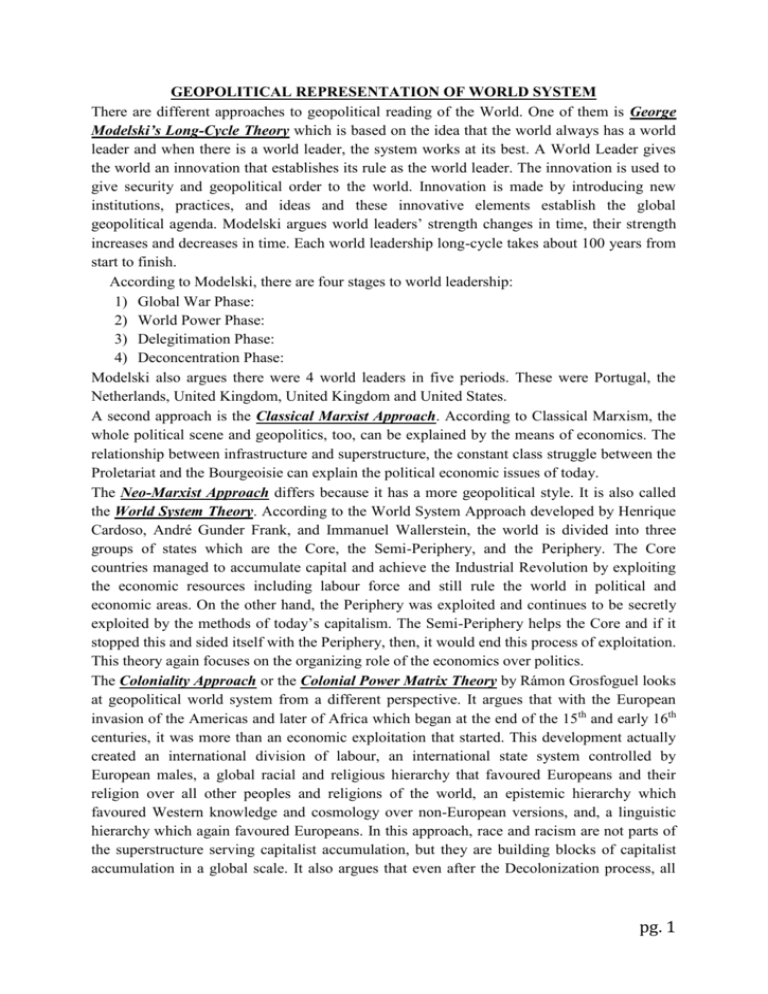
GEOPOLITICAL REPRESENTATION OF WORLD SYSTEM There are different approaches to geopolitical reading of the World. One of them is George Modelski’s Long-Cycle Theory which is based on the idea that the world always has a world leader and when there is a world leader, the system works at its best. A World Leader gives the world an innovation that establishes its rule as the world leader. The innovation is used to give security and geopolitical order to the world. Innovation is made by introducing new institutions, practices, and ideas and these innovative elements establish the global geopolitical agenda. Modelski argues world leaders’ strength changes in time, their strength increases and decreases in time. Each world leadership long-cycle takes about 100 years from start to finish. According to Modelski, there are four stages to world leadership: 1) Global War Phase: 2) World Power Phase: 3) Delegitimation Phase: 4) Deconcentration Phase: Modelski also argues there were 4 world leaders in five periods. These were Portugal, the Netherlands, United Kingdom, United Kingdom and United States. A second approach is the Classical Marxist Approach. According to Classical Marxism, the whole political scene and geopolitics, too, can be explained by the means of economics. The relationship between infrastructure and superstructure, the constant class struggle between the Proletariat and the Bourgeoisie can explain the political economic issues of today. The Neo-Marxist Approach differs because it has a more geopolitical style. It is also called the World System Theory. According to the World System Approach developed by Henrique Cardoso, André Gunder Frank, and Immanuel Wallerstein, the world is divided into three groups of states which are the Core, the Semi-Periphery, and the Periphery. The Core countries managed to accumulate capital and achieve the Industrial Revolution by exploiting the economic resources including labour force and still rule the world in political and economic areas. On the other hand, the Periphery was exploited and continues to be secretly exploited by the methods of today’s capitalism. The Semi-Periphery helps the Core and if it stopped this and sided itself with the Periphery, then, it would end this process of exploitation. This theory again focuses on the organizing role of the economics over politics. The Coloniality Approach or the Colonial Power Matrix Theory by Rámon Grosfoguel looks at geopolitical world system from a different perspective. It argues that with the European invasion of the Americas and later of Africa which began at the end of the 15th and early 16th centuries, it was more than an economic exploitation that started. This development actually created an international division of labour, an international state system controlled by European males, a global racial and religious hierarchy that favoured Europeans and their religion over all other peoples and religions of the world, an epistemic hierarchy which favoured Western knowledge and cosmology over non-European versions, and, a linguistic hierarchy which again favoured Europeans. In this approach, race and racism are not parts of the superstructure serving capitalist accumulation, but they are building blocks of capitalist accumulation in a global scale. It also argues that even after the Decolonization process, all pg. 1 independent countries in the world live according to the European worldview and are exploited by Euro-Americans. The Global Democracy Approach argues that the world is now globalized from above with the capitalist benefits taken in front of every other aspect. However, a globalization from below movement is also developing and it sees democratic values as affecting all areas of life, and asks for the global application of such values as democratic accountability, procedures of participation, and transparency to be applied in every level of social interaction from workplaces to governments around the world. This approach also asks for these issues to be extended to such international organizations as the UN, the EU, the IMF and WTO. This would limit the central role of the nation-state and establish a regime of representative governance related with human security, and make the peoples of the world the centre of this system, not the states. The International Criminal Court is seen as a first step of this process. Geopolitical Codes: Each country has geopolitical codes. One of the key indicators of a country’s position in global affairs and its foreign policy trends is the geopolitical code. When a country orients itself towards the world and evaluates its own position, it is called creating a geopolitical code. Colin Flint –a political geographer– defines it as the manner in which a country orientates itself towards the world,1 while Vladimir Kolosov –another professor of political geography– stresses that the code is a set of strategic assumptions of a government about other governments in shaping its foreign policy. A country’s geopolitical code takes shape through answering these five questions: • Who are our current and potential allies? • Who are our current and potential enemies? • How can we maintain our allies and nurture potential allies? • How can we counter our current enemies and emerging threats? • How do we justify the four calculations above to our public, and to the global community? (This is becoming the key question in the world today). Any geopolitical code has two main variables: namely, scale and orientation. (Taylor and Flint, 2000, p. 62) For example, Great Britain has defined its primary allies within the transatlantic and transEuropean institutions of NATO and the EU. Furthermore, it has tried to retain influence across the globe through the establishment of the Commonwealth, made up of ex-British colonies. The latter has had mixed success, for example the expulsion of Zimbabwe from the Commonwealth for its brutal campaign against white farmers in the face of strong criticism from Britain. The identification of enemies is also dynamic. The history of Russia is a history of its exponentially increasing geopolitical ambitions: from the 15th century feudal Muscovy to the landlocked centralized state at the times of Ivan the Terrible, from Peter the Great’s burgeoning sea power to a supreme colonial empire of the early 20th century. By the end of World War II, the Soviet Union and the U.S. had evolved from regional powers into global powers and shaped the bipolar system of international relations. With the collapse of the USSR, Russia had to choose between a global strategy –for which it clearly lacked both military and economic resources– and a regional one, which was out of tune with its ambitions. As political scientist Thomas Volgy put it, present-day Russia enjoys an overachiever major power status, i.e. its recognized global status is not backed by appropriate resources, and its potential influence upon the global agenda remains mostly insignificant. From the West’s point of view, almost overnight, as the Soviet Union became pg. 2 Russia, it quickly changed from intractable enemy to an ally. In time, though, the Russian Federation is turning into an adversary once more because it does not comply with the Western image of what a European state, political culture, and government should be. The West made a similar strategic mistake by doubting to admit Turkey to the European Union. Too absorbed in trying to define where the borders of the European civilization lie, in petty fights over strategically less significant issues of, say, Northern Cyprus, Europeans seem to have already missed the opportunity to include Asia Minor into the orbit of European identity and obtain (though with no guarantee of success) a key ally in their struggle against Islamic fundamentalism. Europe’s tough pro-Palestinian policy discouraged one more beacon of European identity and European ally in the Middle East: Israel. Failing to accept Russia, Turkey, and Israel as equal partners of the West and its outposts in advancing Western values, Europe shrank back to the mental frontiers of the Middle Age. We might as well be a mere footstep away from the sunset of the European civilization; but rather than dying altogether, it is giving up on its global ambitions. The age-old way of spreading European ideals must have exhausted itself at the beginning of the 21st the century. Europe has made itself a nice little home within the biggest peninsula of Eurasia and stuck to it. Attempts to maintain allies take a number of forms. Economic ties are one chief element in defining a country’s geographical code from our side as our ally. The EU evolved out of relatively modest beginnings to integrate the economies of France and Germany to cultivate a peaceful Europe after the brutality of the two world wars. Cultural exchange is also another vehicle for maintaining or nurturing peace. Educational scholarships such as the Rhodes, Fulbright, andGoethe fellowships encourage international understanding and long-term ties. Business organizations such as the Rotary Club are also aimed at establishing linkages. The choice of “good-will” visits for incoming presidents and prime ministers is indicative of which international relationships are deemed most worthy of attention (Henrikson, 2005). For example, it is a tradition that the incoming US president meets with his Mexican counterpart at an early date. Military connections are also seen as a means to maintain international cooperation. NATO is perhaps the strongest case, in which it is determined that an attack upon one member is considered an attack upon all. Another means of connecting with allies is the sale of military equipment that is expected to tie the, normally, weaker buyer to the more powerful seller. However, there is no guarantee of subservience. Weapons supplied to Iraq during its war with Iran were subsequently seen as threats by the sellers, the United States and Great Britain. Less overt, are the relationships fostered by military training. Understanding the concept of geopolitical codes allows for an analysis of the multiple agendas that countries face and the diversity of policy options that are available to address them. Moreover, geopolitical codes are contested within countries as different political interests within a country seek different policies. Geopolitical agents do not have complete freedom in defining their code, the context of what other, perhaps more powerful, countries are doing must be taken into account. The dynamism of geopolitical codes is a result of the interaction, perhaps inseparability, of domestic politics and the changing global context. One way of defining the global context is through Modelski’s model, though the concept of geopolitical code is still valid and useful without resort to the model of world leadership. In the next chapter, we will concentrate on the fifth element of geopolitical codes: the way they are represented to gain public support. RUSYA: Russian elites have traditionally held that Russia should follow the pg. 3 European track of development, while the masses have held rather anti-Western views. Currently we are seeing sea changes in how the Russian elite view Russia’s geopolitical code. In foreign policy, the regional dimension is getting ahead of the global one, while the pro-Western sentiment is reversing. It is now the first time the political elite in Russia has taken the same stance as the majority of the population and is playing the anti-Western card as leverage in domestic policies. TURKIYE:T the geopolitical representations of Turkey with regard to the nation-state, identity/civilization, and international order. Contrary to the defensive geopolitical vision, the new geopolitical vision in the AKP period has a strong sense of geopolitical continuity within the immediate region of Turkey. This continuity indicates that, given historical, social, cultural, and geo-economic intersections, the territory of Turkey is considered inseparable from its surrounding geographies. This geopolitical reasoning, which gives a unique place to Turkey, negates the country’s defensive geopolitical legacy and republican diplomatic tradition and particularly displaced the Kemalist geopolitical vision in TFP. To be sure, there are many important critiques of Turkey’s new geopolitical vision. The first critique points out that the new geopolitical vision, particularly the practical and formal geopolitical discourse of Davutog˘lu, represents an important continuity 680 M. Yes¸iltas¸ Downloaded by [Cankaya Universitesi] at 00:04 02 April 2015 with the previous geopolitical discourse on the issue of new geographical imagination and the new civilizational awareness particularly put forward by I˙smal Cem. This critical literature has also a strong critique regarding the centrality of the geopolitical view in traditional TFP, and points out that the AKP and Davutog˘lu have the same geopolitical mentality in terms of using geopolitical-laden language in shaping foreign policy. For example, Bilgin defines this centrality as “geopolitics dogma”: “a structure of well-established assumptions as to what geography tells one to do and why this makes sense.”90 Articulated as such, AKP leaders, including Davutog˘lu himself, offer a best example of “geopolitical dogma,” which tends to use a heavy geopolitical conceptualization of foreign policy. However, while some scholars argue that Davutog˘lu’s geopolitical discourse is hierarchical in the sense that Turkey is seeking hegemony over countries in its immediate region, others claim that the new discourse has a state-centric ontology that does not include societal relations in foreign policy.91 Davutog˘lu’s “central country” conceptualization is first and foremost heavily shaped by an orthodox (classical) geopolitical problematique regarding the articulation of geography as a potential material power in foreign policy preferences and as the engine of history in international relations.92 Therefore, what Davutog˘lu understands about geopolitics is of extreme importance in order to examine the basic concepts and world view in the new geopolitical vision. For example, he writes in 1998 that, “geopolitics had a dual role in international relations as a fundamental cause for international crises and wars and as a decisive factor in the re-adjustment of the international system.”93 He has the same idea about the centrality of the geopolitical view in his book when he says that, “strategies should be rooted in geopolitical, geocultural and geo-economic realities.”94 It can be said that he treats geopolitics as a basic factor and as an indication of a power shift in TFP and global politics. However, his examination of geography is not limited to the physical mapping of a location but as a constant in Turkey’s position. In addition to the centrality of geography as a material power, he focuses on the role of culture, religion, history, and civilization as the source of non-material powers shaping Turkey’s geopolitical pg. 4 position.95 Therefore, just as in geography, history too makes a country a central country. Both dimensions are important for Davutog˘lu in rearticulating Turkey’s geopolitical discourse, criticizing previous geographical imaginations and relating Turkey to the international order through the central country position as a geopolitical leverage. This is also valid for AKP leaders when they use geopolitics to frame TFP. AKP’s post-2002 framing of foreign policy was heavily influenced by geopolitical discourse particularly vis-a`-vis Turkey’s perspective of international order, civilization, and its regional and international position. Therefore, the new foreign policy in the AKP era is geopolitically deterministic and reductionist regarding many issues. However, the new geopolitical vision is different in terms of the reformulation of geography, state identity, nation-state, and Turkey’s civilizational belonging. The new geopolitic is more assertive and represents an important rupture from the old geopolitical imagination. In other words, the Transformation of the Geopolitical Vision in TFP 681 Downloaded by [Cankaya Universitesi] at 00:04 02 April 2015 AKP has a liberal-oriented geopolitical practice in shaping Turkey’s regional policy, but at the same time it has a conservative and Islamist geopolitical vision in terms of connecting history and culture to foreign policy. This can be understood by shedding light on the concept of power and its articulation in each geopolitical vision. While power (read, a strong state) is defined in terms of protecting the national and the territorial integrity of Turkey, the new geopolitical vision of AKP leaders uses power to become a regional leader and a global player. In other words, while protectionism is the dominant political expression and the practical foreign policy strategy in the defensive geopolitical vision, within the new geopolitical vision “Turkey as global actor” appears as the dominant expression (Table 3). More importantly, securitization was the main methodology through which Turkey’s geography as a source of insecurity in the defensive geopolitics phase was framed. Flexibility is now the main methodology in the new geopolitical discourse of the AKP. The new geopolitical discourse is also different in the sense that it defines Turkey’s position in accordance with the global geopolitical context and takes civilization as the main axis of Turkey’s geopolitical position. While the global geopolitical context represents the liberal aspect of the new geopolitical vision, the civilizational dimension offers a more conservative strategic alternative for TFP. Additionally, in the new geopolitical imagination, geopolitics is seen as an important facilitating factor in becoming a global player that shows Turkey’s assertive and ambitious foreign policy in the international order. This can be illustrated by looking at the new definition of diplomacy in Turkey. Davutog˘lu defines diplomacy as follows: “There is no frontline for diplomacy but rather an arena comprising the whole world.”96 According to this definition, the borders of Turkey’s geographical imagination are not limited to one region or one country. Rather, they are ambitiously constructed within the entire world. This is a remarkable transformation from a protectionist diplomatic tradition to one that perceives opportunities, friends, and potential allies all across the world. Last but not least, the new geopolitical vision has a strong sense of geo-economic awareness for Turkey’s rising economic power and neo-liberal economic order. However, the new geopolitical vision does not propose any specific alternative economic model against the liberal economic order. To put the matter bluntly, Turkey’s economic policies during the last decade have been built in accordance with the neo-liberal economic policies and order. Therefore, while Turkey discursively is very critical against the liberal international order and pg. 5 demands structural change within this global economic system, it has economically internalized and justifies itself in the different dimensions of neo-liberal order. To be sure, this is a structural and systemic problem for all the rising powers in the international system. GEOPOLITICS The basic elements of the classical geopolitics are re- sumed in a few words: the state is conceived as a living organism, therefore borders are conceived as flexible (they change in the course of the iife' of the state, in other words a state enlarges its territory when its strengths are growing at the expense of older states in decline); finally, following social Darwinism, the evolution of the political organism is determined by its environment. Typical for the classical geopolitics is geographical determinism as opposed to the 'possibilism' advocated by the French school of geography. In geopolitics, four 'approaches'. The names and the delimitation of these 'geopolitical schools' is somewhat arbitrary but it reduces effectively the great diversity encoun- tered in the publications related in one way or the other to geopolitics. These four schools are distinguished on two di- mensions. The first is the distance to the object under study: at the one hand practical advises to political actors are highly recommended, at the other hand academic reflections refrain from ties with geopolitical policies. The second refers to the position towards the state system: at the one hand states are conceived as the principal geopolitical actors, at the other hand attention is paid to other political actors and to the in- ternal diversity and the conflict of interests inside the states. In neoclassical geopolitics, the strategic value of spe- cific attributes of territories play the leading role. Next to 'geopolitics', the core concept is 'geostrategy'. Neoclassical geopolitics correspond to what the layman expects geopoli- tics to be: it is about the effects of geographical location and other geographical features on the foreign policy of a state and its relations with other states. It is also concerned with the strategic value of geographical factors (resources, access to the sea, etc.). This also corresponds to the definitions provided in general dictionaries. In this context, Napoléon Bonaparte is often quoted: 'La politique d'un état est dans sa géographie' (e.g., as an epigraph in the atlas of Chaliand andRageau, 1983)2. Neoclassical geopolitics distinguishes itself from clas- sical geopolitics on many points. First, the state is not conceived as an organism, and borders are given. The state remains however a black box: reasoning occurs in terms of 'national interest' and 'national security' as if the state was one person. There is a sharp distinction between internal affairs and foreign policy. The world of international relations remains the domain of experts. Subsequently geo- graphical determinism is no more at stake, but a powerful contextual effect is considered. The physical environment puts restraints and offers opportunities: 'geography does not repeat itself states Neville Brown in a reflection about the growing length of the war front (Brown, 1992, pp. 7476). During the eighties, there was a growing interest for nuclear geopolitics, this means geopolitics and geostrat- egy in the nuclear age. In a reader published in a series of the NATO Scientific Affairs Division (Zoppo and Zorgbibe, 1985), the geopolitical analysis of the nuclear deterrence is introduced as an improvement to the realistic approached to international relations. It was also in the circles of the North-Atlantic Treaty Organisation that the Institut interna- tional de géopolitique/International Institute of Geopolitics has been established in 1982 in Paris and Washington, under the leadership of the French Gaullist Marie-France pg. 6 Garaud. The institute publishes under the title Géopolitique two journals, one in English and one in French. Among the founding members of the institute one can find diplomats, politicians, military experts and academics (such as Huntington and Luttwak). Special issues of both journals are typically de- voted to hot items in term of security: the USSR, the Gulf War, Space, Islam, etc. The classical elements of Mackinder's geostrategy are still considered to be important, e.g., the traditional theme of maritime superpowers (Modelski and Thompson, 1988; Gray, 1988; Girardet, 1989; Gallois, 1990; Chaliand, 1990; CoutauBégarie, 1985a, 1995), the control of specific seas and islands (Coutau-Bégarie, 1985b, 1987, 1993; Besnault, 1992; Cordonnier, 1995; Vigarié, 1995; Catley and Keliat, 1997; SimpsonAnderson, 1997), the strategic relevance of specific regions (Hafeznia, 1994 on Kashmir; Delavaud, 1993 on Asia; Martel, 1991 on Libya) or the importance of geopolitical insights for security policy of one's country (Brill, 1994). Moreover geopolitical analyses have been published regarding new resources and energy sources, drinking water, etc. In The Strategic Revolution (1992) Neville Brown brings up poverty in the Third World, the global climate change and environmental issues (see also Brown, 1994, for a study of water as strategic resource, see also Sironneau 1996; and Perkins, 1997 on the relation between national security policy and high yielding agriculture). In the eighties and nineties, many atlases have been man- ufactured to portray a global view of the uneven distribution of resources and of conflict sources (Chaliand and Rageau, 1983, 1985; Touscoz, 1988; de Marensches, 1988; Val- laud, 1989; Boustani and Fargues 1990; Boniface, 1993; Chaliand, 1993; Chaliand and Jan, 1993; Kidron and Segal, 1981, 1984; Kidron and Smith, 1983; Freedman, 1985; An- derson, 1993; Seager, 1995). It is also worth mentioning the noticeable handbook Strategic Geography: NATO, the War- saw Pact, and the superpowers by Hugh Faringdon (1989), a revised edition of Confrontation first published in 1986 (see also Segal, 1986). Reference books in this tradition include a lexicon (Soppelsa et al., 1988) and two dictionaries (Zorg- bibe, 1988; Piano and Olton, 1988) both rendered largely obsolete by the fall of Communism and the USSR. Subversive geopolitics: everything is geopolitical! At the end of the seventies, the term 'geopolitics' acquired a subversive meaning in France with the help of Maoist ge- ographers. Geographical knowledge is important for those waging war, hence the observation of the French geographer Yves Lacoste who entitled his radical analysis about geography La géographie ça sert d'abord à faire la guerre (1976). His analysis of the logic behind the bombardment of the dikes in North-Vietnam by the American army made Lacoste famous in the US. Because there are as many points of view as there are protagonists (Lacoste, 1986, p. xvi), the word is used in the plural, les géopolitiques, contrary to the conventional usage in French, e.g., la géopolitique. Furthermore the geopolitical approach can be applied at different levels of analysis: ies états n'ont pas le monopole de la géopolitique' (Lacoste, 1986, p. xiii). The analyses focus naturally on the nature of the claims of the political actors in a particular area. Lacoste speaks of 'représentations géopolitiques' a reference to theatre and tragedy. Maps play a special role in the development and the diffusion of such representations. Finally, the territorial conflict (rather than the state or the state system) is the unit of analysis. As mentioned earlier, this geopolitical approach is ap- propriate for all territorial conflicts: ergo also inside states. Internal geopolitics have become more and more impor- tant in Lacoste writings as witnesses by the publication in 1986 of the three volumes of Géopolitiques des pg. 7 régions françaises. The three volumes of this reference book deal with the 22 administrative regions in metropolitan France (but not the areas overseas). The analyses consist essentially of what others would call electoral geography. In democracies, elections are pre-eminent opportunities for geopolitical views to compete with each. At the same time, a special issue entitled Géopolitiques de la France dealt with internal and external geopolitical themes (such as the formation of the départements in 1790 and the relationship with Germany). A look at the themes discussed in Hérodote in the nineties confirms its nationalistic preoccupations, but most issues reach much further than the French nation and the French interests, for example special issues such as the Balkans (nr. 63, 1991), the remains of the Soviet Union (nr. 64, 1992), Serbia (nr. 67, 1992), Japan (nr. 78-79, 1995), the Caucasus (nr. 81, 1996), SouthAfrica (nr. 82-83, 1996) or Indonesia (nr. 88, 1998). Nevertheless, the nation is cur- rently the dominant subject in the work of Lacoste as shows his recent book Vive la nation! (1997) and in Hérodote with a series of special issues on the national question (on Italy and on Spain in 1998, one on the United Kingdom has been announced). Other publications6, sometimes (based on) PhD the- ses defended at the Centre de Recherches et d'Analyses Géopolitiques (Paris VIII), include the analysis of German Geopolitik by Michel Korinman (1990, 1991) and the study of the Basque Country conducted by Barbara Loyer (1997). In 1991, Michel Foucher published a revised edition of his encyclopedic study of borders and their constitution in Europe (1988, 1991, see also regarding the new states in Central Europe: Foucher, 1993, 1996). The distinction between subversive and neoclassical geopol- itics fades away when the first approach deals with states and their relations, although subversive geopolitics pays more attention to contradictory interpretations of the national in- terest. Subversive geopolitics has been influential among political scientists too, such as Pascal Lorot and François Thual who wrote extensively about the history of geopolitics and the geopolitical method (Lorot, 1995; Thual, 1993a, b, 1995b, 1996a, 1997b; Lorot and Thual, 1997; Thual and Chaumade, 19988), specific regions or specific religions. Another interesting contri- bution is the Géopolitique et géostratégies des drogues by Labrousse and Koutzousis (1996) in which the drugs wars between drugsmafias and states have been analysed. Last but not least, geoeconomics has been paid attention too. One of the political scientists mentioned above, Pascal Lorot, is the director of the Revue française de géoéconomie. Its first issue was published in March 199711. In his intro- ductory article De la géopolitique à la géoéconomie (Lorot, 1997, pp. 23-35) Lorot introduces and criticises Luttwak's approach (see above) before formulating his own research agenda. According to Lorot, geoeconomics is the analysis of the economic strategies of the states (Lorot, 1997, p. 29) especially those regarding international trade. The first issue, entitled Pourquoi la géoéconomie? contains further an interview with Yves Lacoste who declares himself in favour of this new approach as a complement to geopolitics, but certainly not as a substitute. Moreover contributions are devoted to the relation between states, enterprises and markets, to monetary issues and to the importance of technology. Finally, the geographer and former Hérodote-editor Michel Foucher, presently the director of the Observatoire européen de géopolitique, has also discussed geoeconomics as the new dogma. He emphasises that geoeconomics is practiced by states between which war is no longer conceiv- able (Foucher, 1997). pg. 8 Non-geopolitics: the political geography of international relations Outside France, geographers rediscovered geopolitics too. I have called this school non-geopolitics because it is about the 'neutralisation' of geopolitics. These geographers op- pose the abuse of geographical knowledge and plead for a scientific, neutral, geography of international relations. This school originates in the revival of political geography at the end of the seventies and the beginning of the eighties. In January 1982 the first issue of Political Geography Quarterly is delivered. The opening is a research agenda in which the editors in chief, Peter J. Taylor en John O'Loughlin, list 21 themes that deserve the attention of political geographers. Three of them are related to geopolitics: geographical perspectives on the relations between states, one concerns the revival of geostrategic studies (Ed- itorial Board, 1982, pp. 9-10) implicitly. implicitly. The two editors also notice that the geostrategic analysis by Sir Harold Mackinder is no doubt the most famous political geographical piece outside the field. Moreover, they maintain that the East-West conflict displays many similarities with the two powers-model put forward by Mackinder, but they mention many developments that call for further research in the field. Non-geopolitics is the study of the spatial distribution of power between states (Taylor, 1993, p. 330), especially between the major powers and supranational actors such as such as the United Nations or NATO (O'Sullivan, 1986). This school comprises, beside political geographers, the po- litical scientists involved in the so called 'peace studies' (as opposed to strategic studies). For that reason, this approach could also be called peace-geopolitics15. It is a matter of patterns in international relations: the political geography of war and peace. Jan Nij- man examines the pattern of the involvement of the two super powers in armed conflicts of third parties during the Cold War. Since the end of the Cold War, the configuration of the new world order to replace the familiar ideological op- position between East and West has been a major topic of investigation. Awaiting a new world order (c.q. a geopolitical order) we find ourselves in a geopolitical transition: a few options are open. The non-geopolitical au- thors explore these options through scenarios. Peter J. Taylor looks back to the previous transition, to the beginning of the Cold War to review the options available to the British government at the time and (geoeconomic, geopolitical and geostrategic) dilemmas this world power in decline had to confront (Taylor, 1990). Political scientists are discussing the geopolitical transition as well. A recent example of their work is the collection of essays published by the International Peace Research Institute in Oslo under the title Geopolitics in Post-Wall Europe, Security, territory and identity (Tunander et al., 1997). This volume is an exploration of the new European order, especially regarding the position of the state in the light of the European unification. Subsequently the book scrutinises the position of Russia (inside or outside Europe?) and the consequences for the geopolitical order in Europe: will the Cold War be followed by a Cold Peace? Finally attention is paid to the construction of the 'other', the Islamic world and the specific role of the Balkan as a buffer between Europe and the 'other'. Finally, geoeconomic themes are not foreign to non- geopolitics either (e.g., O'Loughlin, 1993; Lele and Ofori- Yeboah, 1996; Gupta, 1997) but the approach is still much more statecentric than the analysis of the geopolitical con- sequences of capitalism provided by David Harvey a decade earlier: it focuses on the economic competition between states whereas Harvey was presenting a theory in which the dynamics of capitalist accumulation explains state formation and geopolitical relations between states (Harvey, 1985). pg. 9 Post-structuralistic geopolitics: critical geopolitics Critical geopolitics is a new flag and it is a self-designation by contrast with the other 'labels' presented here. The term has been introduced in the United States in the course of the eighties21 : it points originally to studies of foreign policies by means of discourse analysis. This approach is embedded in the poststructuralism of French philosophers such as Jacques Derrida and Michel Foucault in which discourses are deconstructed. Geopolitical perceptions are problema- tised, knowledge and discourses about the geographical features of international relations are the very research object. This approach belongs to a broad school of post-modern social sciences involved in discourse analysis. One of the authoritative authors in this subfield, Gearóid Ó Tuathail22 distinguishes three dimensions to critical geopolitics: the deconstruction of geopolitical traditions, the deconstruction of contemporary discourses and the exploration of the meaning of spatial concept such as 'place' and 'politics'. Ó Tuathail and Dalby (1998b) iden- tify three kinds of geopolitics: popular geopolitics (in mass media, cinema, novels or cartoons), practical geopolitics (foreign policy, bureaucracy, political institutions) and for- mal geopolitics (strategic institutes, think tanks, academia) all three contributing to the spatialising of boundaries and dangers (the geopolitical map of the world) and the geopo- litical representations of self and other (the geopolitical imagination). Critical geopolitics focus at first and foremost on the geopolitical arguments in the foreign policy of the United States. In Creating the Second Cold War, the Discourse of Politics (1990) Simon Dalby analyses the arguments of those who agitated against the détente in the US at the beginning of the eighties. After the détente activated by the Republican President Nixon and his Foreign Affairs Secretary Henry Kissinger, a new 'freezing' was advocated. Dalby examines in the first place the publications of a lobby group called the Committee on the Present Danger which was popular under Ronald Reagan. Besides policy acts and speeches by politicians and diplomats, ample attention is paid to the mass. Other topics include international migrations as threats, discourses on local workfare as opposed to federal welfare in US. Many contributions deal with the theoretical bases of critical geopolitics, the connections with 'development theory, or 'gender theory', the meaning of key concepts such as territoriality and sovereignty after the Cold War. Finally, the deconstructivistic approach has been applied to internal conflicts regarding power and territory, e.g., political culture (Bonura, 1998), national identities in Turkey (Rygiel, 1998), the shaping of Finnish provinces (Häkli, 1998a, b), the Oklahoma bombing (Sparke, 1998), the territorial tactics of the Los Angeles police department (Herbert, 1996, 1997), movements of resistance such as the Zapatista insurgency in Chapias, or urban segregation in South Africa (Robinson, 1997), whereas Charlesworth (1994) analyses discourses about the commemoration of the holocaust. The borderline between critical geopolitics and nongeopolitics fades away as empirical political geographers pay attention to the perceptions of geographical features, respectively to power relations between political actors. The other way round, the distinction evanesces when authors analyse 'geopolitical discourses' not only as text but also in the institutional and material context in which they are formed and popularised. The separation between internal and external affairs is then directly contested (see also Rosenberg, 1994), as in the books by David Campbell about the connection between foreign policy and national identity (1992) and the 'narratives' over the Gulf War (1994). Both types pg. 10 of 'academic' political geographers join efforts in several collections of essays and special issues of academic journal. In the different approaches, all core elements of classical geopolitics are knocked into pieces. Even the very existence of the state as a territorial construct is challenged: some authors think that state borders do not amount to anything much in the global economy, or that states are undermined by the rise of supranational and subnational authorities, whereas others consider that the feature of the state as identity construct is much more important than its territorial component. And the views regarding the actual geopolitical (dis)order diverge too, although there is a common and growing attention for the economic competition between states. Correspondingly geoeconomics supersedes more and more often geostrategy as the twin sister of geopolitics. pg. 11

